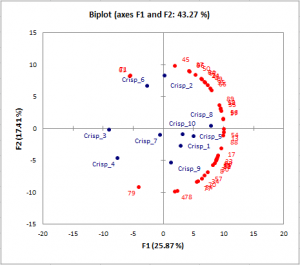Internal preference mapping
Internal Preference Mapping (IPM) allows identifying correspondences between products and consumers. Available in Excel using the XLSTAT software.

What is preference mapping?
Preference Mapping allows to build maps which show the preference of consumer for a type of product. A preference map is a decision support tool in analyses where a configuration of objects has been obtained from a first analysis (PCA, MCA, MDS), and where a table with complementary data describing the objects is available (attributes or preference data).
There are two different preference mapping methods:
- The one presented here - internal preference mapping
- PREFMAP or external preference mapping
What is internal preference mapping?
Internal Preference Mapping (IPM) is based on Principal Component Analysis (PCA) to allow identifying which products correspond to groups of consumers.
The data used in an internal preference mapping analysis is a table of judges or customers grading products. The general representation of the internal preference map is the projection of the products in the space defined by the judges. The more judges around a product, the more popular that particular product is.
While PCA does not filter out variables, this internal preference mapping tool allows removing (after the PCA step) from the plots the judges that are not well enough displayed on a given 2 dimensional map. The measure of how well a point is projected from a d-dimensional space to a 2-dimensional map is named communality. It can also be understood as the sum of the squared cosines between the vector and the axes of the sub-space. The biplot that is then produced is not a true biplot as all the retained judges are moved on a virtual circle surrounding the product points in order to facilitate the visual interpretation.


analyze your data with xlstat
Included in
Related features